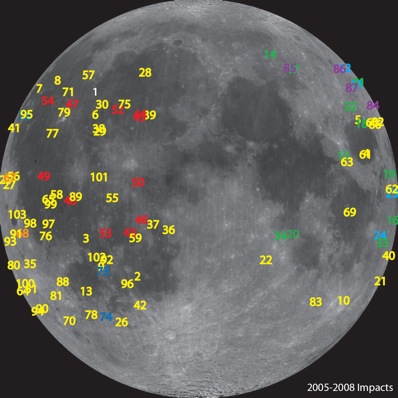|

Over 100 lunar impact explosions caught in the act
BY DR EMILY BALDWIN
ASTRONOMY NOW
Posted: May 21, 2008
103 meteroids striking the lunar surface at speeds of around 50,000 kilometres per hour, capable of blasting craters a metre wide, have been caught on film by NASA scientists.
Not so long ago, anyone claiming to see flashes of light on the Moon would have been consigned to Crackpot Corner. But over the last two and a half years, NASA astronomers have observed 103 flashes from our nearest neighbour, caused by the impact of meteoroids heating up the surface rocks to temperatures hot enough to glow, and this number is rising every day.
"We started our monitoring program in late 2005 after NASA announced plans to return astronauts to the Moon," says team leader Rob Suggs of the Marshall Space Flight Centre. “If people were going to be walking around up there, it seemed like a good idea to measure how often the Moon was getting hit. Almost immediately, we detected a flash.”

A site map of the first 100 explosions observed on the Moon since 2005. Details of the impact flashes can be found at www.nasa.gov/centers/marshall/news/lunar/ Image: Science@NASA.
The impact flashes can occur with a frequency of up to one per hour, or more, when the Moon (and Earth) pass through dense streams of cometary debris during known meteor showers. However, even when there is no meteor shower, this number never falls to zero. The background flashes are thought to come from bits of stray comet dust and chips of old asteroids, which pepper the Moon in small but significant numbers.
"That's an important finding," says Suggs. "It means there's no time of year when the Moon is impact-free."
Fortunately, the odds of a direct hit to an astronaut are slim. “If, however, we start building big lunar outposts with lots of surface area, we'll have to carefully consider these statistics and bear in mind the odds of a structure getting hit,” says Bill Cooke, head of NASA’s Meteoroid Environment Office.
What is of even greater concern is the spray of debris thrown up after an impact event: A single meteoroid produces a spray consisting of thousands of secondary particles all traveling at bullet-like velocities. "Secondary particles smaller than a millimeter could pierce a spacesuit," says Cooke. Understanding how far and wide secondary particles travel is the focus of another area of research that the team are conducting by shooting artificial meteoroids at simulated moon dust and measuring the spray.

A pyrex marble exploding on impact with a simulated lunar surface, as demonstrated by scientists using the NASA Ames Vertical Gun Range to investigate the effect of secondary impacts. Image: P. Schultz, Brown University/NASA.
Many of the impact flashes that occur on the Moon can be imaged with amateur telescopes. Keep an eye on http://science.nasa.gov/ for details of how amateur astronomers can participate in this exciting research.
|



